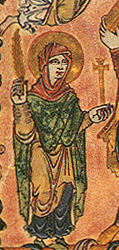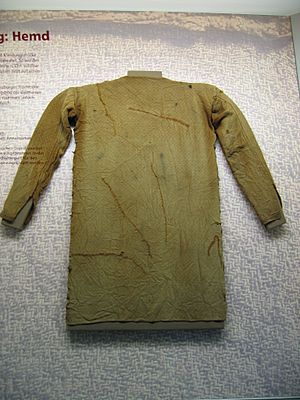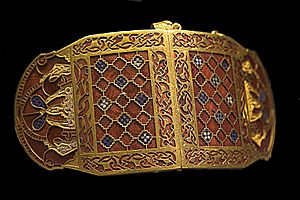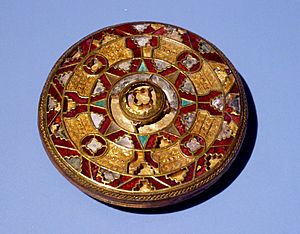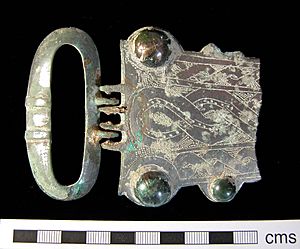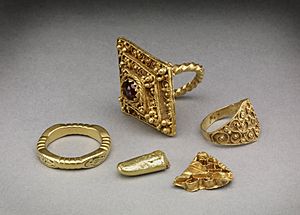Anglo-Saxon dress facts for kids
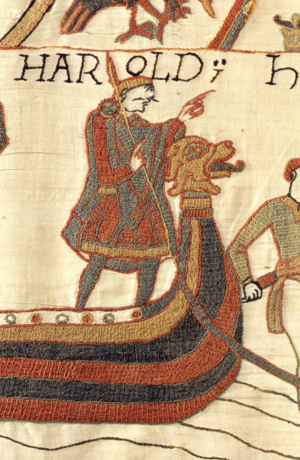
Anglo-Saxon dress refers to the clothes and accessories worn by the Anglo-Saxons from the mid-400s to the 1000s. We learn most about their clothing from items found in Anglo-Saxon burial sites. By combining these finds with Anglo-Saxon and European art, writings, and stories from that time, we can figure out what they wore. Sometimes, what we find in graves matches the old pictures and descriptions, and sometimes it doesn't!
Things found in graves show that men's and women's clothes were different. Women's fashion changed often over the centuries, but men's clothes stayed pretty much the same. Women usually wore jewelry, while men wore little or none. In the early 600s, Anglo-Saxon kingdoms started to become Christian. Religious art, symbols, and writings from this time greatly influenced clothing, especially women's dresses and jewelry. We also know that Anglo-Saxon children wore smaller versions of adult clothes.
At first, clothes for soldiers, important people, and religious groups were similar to what everyone else wore daily. But over time, as European culture and Christianity spread, and as Anglo-Saxon England became richer, special clothes and accessories became common for each group. This helped people tell them apart.
During the Anglo-Saxon period, clothes were made from natural materials. These included wool from sheep, linen from flax plants, and silk that was brought in from other countries. In the 400s and 500s, women made clothes by weaving fabrics on looms in their homes. From the 600s to the 800s, Anglo-Saxon communities slowly changed from small villages to a mix of small and large settlements, and big estates. On these large estates, special workshops made textiles and clothes for everyone living there. In the 900s and 1000s, cities grew across England. This meant more types of fabrics, clothes, and accessories were available to people. It also changed how these items were made.
Contents
Anglo-Saxon England: A Quick Look
Time Periods
The end of Roman rule in Britain meant Roman armies left in the late 300s and early 400s. By the mid-400s, many Germanic peoples arrived in England. Some left their crowded homes in Northwestern Europe, while others fled rising sea levels on the North Sea coast. The mid-400s marked the start of the Anglo-Saxon era in England.
The Anglo-Saxon era is split into three parts:
- The early Anglo-Saxon period: Mid-400s to early 600s.
- The middle Anglo-Saxon period: 600s to 800s.
- The late Anglo-Saxon period: 900s and 1000s, up to the Norman Conquest in 1066.
What Clothes Told Others
In Anglo-Saxon England, clothes and accessories helped show who a person was. They showed their gender, age, where they came from, their job, and their importance. At first, the early settlers in England showed their Germanic background through their clothing choices. Later, Anglo-Saxon fashion was shaped by European styles, art, and Christian symbols. Wearing certain clothes or jewelry could show that a person was Christian. For example, cross designs appeared on brooches in Kent as early as the late 500s. Small crosses also started showing up on shoulder clasps and belt buckles in Kent in the 600s.
Clothes and accessories ranged from simple and practical to fancy and expensive. Ordinary people usually owned one main outfit, which they wore every day. Their clothes were often old, out-of-style items that had been passed down. Richer people usually had many clothes and accessories. These were often made with high-quality and costly materials, and decorated with amazing details.
Clues from Graves
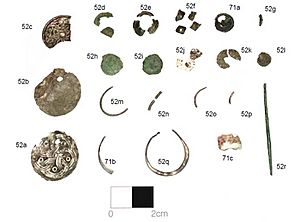
Archaeological finds in Anglo-Saxon cemeteries give us the best information about Anglo-Saxon clothing. In the early Anglo-Saxon period, people who followed pagan beliefs would bury items with the clothed body. Digs from this time have found many artifacts. Experts study these items and compare them to Anglo-Saxon and European art and writings to figure out what people wore. We have lots of evidence for women's burials from the 400s and 500s. But there's less evidence for men's burials, mostly just belt buckles, other belt parts, and a few pins.
In the early 600s, people stopped burying items with the dead. This change happened when Anglo-Saxon England became Christian. From the 700s onwards, only simple items like knives and belts were buried with people. This lack of clothing items makes it harder for historians to know what Anglo-Saxons wore from the 700s to the 1000s.
Sometimes, what's found in graves supports what old pictures show, and sometimes it doesn't. For example, finger rings have been found in both men's and women's graves, but they never appear in Anglo-Saxon pictures. On the other hand, penannular brooches, arm-rings, and neck-rings sometimes appear in Anglo-Saxon art, but they haven't been found in any Anglo-Saxon graves.
Women's Fashion
400s to 500s
Experts have recreated women's clothing from the 400s and 500s based on brooches found in pairs at the shoulders. We are still learning more about women's dresses from this time. It's thought that women's main dresses were ankle-length, as women in Anglo-Saxon art are usually shown in long clothes. However, there's no direct proof of this from archaeological finds.
Experiments to recreate early Anglo-Saxon women's clothing suggest an outfit with a long under-gown. A buckled belt would hold items like knives, keys, good luck charms, and weaving tools. Over this, a short peplos (a simple garment) was worn, which could be easily lifted to reach the tools.
A woman's age often decided her daily outfit. The peplos, pins, and a belt with tools and keys were important for women of childbearing age and for married women. The peplos was usually worn from the teenage years until a woman was in her forties, past childbearing age. This long garment, with its two shoulder brooches, was comfortable for breastfeeding and could easily expand during pregnancy. While most finds are long, some think a shorter one might have been worn. Although the peplos was usually for teens, some finds show girls as young as eight wearing it. But they used one brooch instead of two to show their younger age.
From the 400s, women in Kent wore slightly different clothes, influenced by styles from the Frankish Empire. Their outfit included a front-fastening garment and a Frankish-style jacket, held by four brooches. In the late 500s in Kent, women's dresses were fastened by a fancy disk brooch at the throat, replacing the jacket with four brooches. Other regions had their own styles. For example, in Anglian areas, wrist clasps, a third central brooch, and special 'girdle-hangers' were common. Women's clothing across England was made prettier with beads of glass, paste, and amber, and sometimes crystal. Strings of beads often hung between the shoulder brooches. Other bead clusters hung from brooches, were attached to belts, or worn alone.
Main Clothes
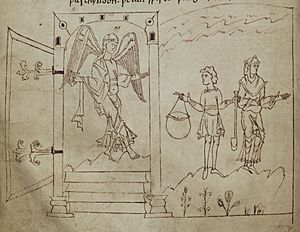
The typical women's outfit of this time was a long, peplos-like garment. It was pulled up to the armpit and worn over a sleeved under-garment, usually another dress. Brooches fastened the garment from front to back at the shoulders. Anglo-Saxon women might or might not have worn a head covering. The dress could be belted, and easily adjusted if a woman's weight changed. We don't know what the Anglo-Saxons called this peplos-style gown.
Linen or wool could be used for the peplos. Historians debate if the choice of fabric changed with fashion over time or if it was different in various regions. Fashion changes often started in eastern England, reflecting European styles, and slowly moved west to the West Saxon region.
We rarely find fur in Anglo-Saxon graves. It's likely that animal fleeces and furs were used as linings or as warm outer garments. A simple poncho with a neck-opening could have been made from sheep or cattle skins. Old writings confirm that fur garments were used, mostly in the late Anglo-Saxon period.
Accessories
Footwear from early Anglo-Saxon graves is rare until the late 500s and 600s. Pictures in Anglo-Saxon books show farm workers plowing and sowing barefoot. This might mean that shoes weren't common until the middle Anglo-Saxon era. Fasteners made of natural materials are rare finds. However, evidence from towns shows that Anglo-Saxons were good at working with bone, horn, antler, and wood. Cattle, deer, goat, pig, and sheep skins were used to make leather goods. Only tiny bits of leather survive, usually attached to buckles and wrist clasps. Leather was probably used for belts, straps, and cuffs, though cloth was also used for these items.
600s to 800s
As Christianity spread in 600s England, religious art and European fashion influenced changes in women's clothing. These changes included the disappearance of paired brooches, except for very small ring-shaped ones. Sometimes, fancy round brooches were worn alone. Linked pins appeared in the 600s. There were fewer bead ornaments than before, and amber beads mostly disappeared.
Main Clothes
Changes in Anglo-Saxon women's fashion began in the late 500s in Kent and spread to other regions in the early 600s. These changes show less influence from Northern Europe and more from the Frankish Kingdom and the Byzantine Empire. There was also a return to some Roman styles. Linen was used more widely for clothes and undergarments. We have little proof if women wore leggings or stockings under their gowns, but it's very likely they did, as men usually wore them during this time.
Accessories
During this period, women's jewelry, besides brooches for fastening clothes, included simple neck ornaments. These were small glass beads or strands of beads on metal rings, hung from shoulder to shoulder over garments. This style lasted until the late 600s. This era is known for the decline of the paired brooch fashion. Amethyst beads started appearing, along with necklaces of gold and silver wire. Small jeweled crosses also appeared as a symbol of being Christian. Sometimes, fancy round brooches were worn at the throat. Linked pins were now found in graves. There were fewer bead ornaments than before, and amber was no longer used.
900s and 1000s
In the 900s and 1000s, as cities grew across England, more types and amounts of fabrics, clothes, and accessories became available to Anglo-Saxon women. Textiles and accessories could be made in large quantities, making them more affordable. For richer women, finer materials and more expensive clothing and jewelry were easy to get.
Outer Garments
Many names for cloaks appear during this time, including basing, hacele, mentel, and rift. A cloak draped around the shoulders and fastened with a brooch was popular, but its popularity was decreasing. Hooded cloaks attached by a round brooch are described in writings from this period.
Main Clothes
Art from this time shows women wearing sleeveless outer garments, sometimes with a hood. Women in late Anglo-Saxon art are shown wearing hooded clothes: either a scarf wrapped around the head and neck or a separate head covering with an opening for the face. It was thought that the hooded style was influenced by Near Eastern art. Women are shown wearing ankle-length, fitted gowns. Gowns often have a clear border, sometimes in a different color. In the 900s, women's arms were usually covered. Sleeves were straight, with a slight flare at the end. Braided or embroidered borders often decorated sleeves. By the 1000s, many sleeve styles were in fashion.
There is little proof if women wore leggings or stockings under their gowns in the 900s and 1000s. However, it's likely they did, as men usually wore them during this time.
Accessories
The girdles and buckled belts that were popular in the 400s and 500s, with tools and personal items hanging from them, went out of fashion by the 900s.
In art from this period, women wear simple ankle shoes and slippers. They were usually black, but with a contrasting strip of color on top. Archaeological finds from this period show that women wore a variety of shoe styles.
Men's Fashion
Anglo-Saxon grave digs have found little proof of what men wore. Weapons were often buried with men, but clothing accessories were less common, except for belt buckles. The lack of fasteners and brooches in men's graves meant few fabric pieces of men's clothing survived. The few fabric pieces found were in good enough condition to be studied.
To figure out men's clothing from the Anglo-Saxon period, experts look at writings, art, and archaeological finds from northwestern Europe and Scandinavia from earlier centuries and during the Anglo-Saxon era. Romans in the 100s AD described Germanic tribes using fur and skin clothes. With the invention of the warp-weighted loom around 200 AD, wool clothing became available for men. This might have replaced or reduced the need for fur and skin garments.
400s to 500s
Outer Garments
Anglo-Saxon men in 400s and 500s England dressed similarly, no matter their social rank. Fashions included the cloak, tunic, trousers, leggings, and accessories. Roman sculptures of Germanic captives show short cloaks made of cloth. These cloaks were clasped on one shoulder. Drawings and paintings from the late Anglo-Saxon era show men wearing similar cloaks, fastened with round brooches. It's likely this style was worn by Germanic tribes on the continent and later when they moved to England.
Men's grave finds from the 400s to 600s rarely include brooches. Any metal pieces found were usually pins in the chest area. It's likely that men used brooches made of materials that don't last, or they secured their cloaks with leather or cloth ties. They might also have worn cloaks without clasps, or used poncho-style cloaks.
Because there are few Anglo-Saxon male grave finds, archaeologists have looked at older European writings and finds from Scandinavian peat bogs to guess what Anglo-Saxon men might have worn. It's likely that a short, fur-lined cloak was used, with the animal skin facing outwards and the fur touching the undergarments.
Main Clothes
Roman writers and sculptures of Germanic men show knee-length or shorter tunics with either short or long sleeves. Clasps weren't needed for the tunic because it would fit snugly around the neck when pulled over the head, meaning it was one continuous piece. A belt or girdle was usually worn with the tunic. It might have had a buckle and, as historian Gale Owen-Crocker says, "pouched over the belt."
Historians are pretty sure that Anglo-Saxon men wore trousers. The Roman poet Ovid described Germanic barbarians wearing trousers. Ankle-length trousers are also seen on Roman sculptures of Germanic men, often with a short tunic, tied at the waist with a belt or draped with a cloak. It's likely that Anglo-Saxon men wore either baggy or narrow trousers, belted at the waist. They might have been attached to the legs with garters or leggings. If loose, the extra fabric was gathered around the waist and, as Owen-Crocker describes, "hung in folds around the legs." Garters or leggings probably went with narrow trousers.
Leggings and Footwear
Leg-garments, or leggings, were usually worn in pairs. These items gave extra protection for the legs. Old writings from this era show that early Anglo-Saxon men wore two types of leg-garments. The first type of leggings would have been a leather or cloth stocking. The second type was most likely cloth strips or wool tied around the leg. Wrapping strips around the legs had the added benefit of being able to cover the foot for extra warmth and protection.
Footwear has not been found in Anglo-Saxon graveyards in the 400s to 500s. It's likely that Anglo-Saxons, especially farm workers, went barefoot. However, old documents show that several shoe types were used: slippers, raw-hide pampooties (simple moccasins), and pouch-like foot coverings. Anglo-Saxons most likely covered their bare feet, except when working. Shoes were probably made of leather and fastened with straps. Hats and hoods were commonly worn, as were gloves and mittens.
Accessories
The only male accessory often found in Anglo-Saxon cemeteries is belt hardware. Men's belt hardware tended to be fancier than women's. Leather pieces have been found in men's graves attached to buckles, which means leather belts were likely a common accessory. Men usually carried a knife, other tools, and sometimes good luck charms at their waist.
Jewelry was found in very few men's graves from this period. Some beads have been found in male burial sites and might have decorated a belt or weapon. Anglo-Saxon writings from this time suggest that men often wore rings, but very few rings have been found in Anglo-Saxon men's graves.
600s to 800s
This era saw the end of burying many items with the dead, but it also included some of the richest male burials of the Anglo-Saxon era. The best example is the Sutton Hoo ship burial, from the early 600s. It's believed to be the burial of a king.
Writings from an 700s historian, Paulus Catena, describe Germanic peoples in Italy at this time: "Indeed their clothes were roomy and especially linen, as the Anglo-Saxons were accustomed to have, embellished with rather wide borders woven in various colours." Paulus's description of Anglo-Saxons wearing linen is confirmed by 700s writers, Bede and Aldhelm. Linen was likely the preferred fabric over wool for clothes worn in 700s Anglo-Saxon England.
Several clothing references appear in 600s and 700s letters. Letters between King Offa of Mercia and the Frankish Emperor Charlemagne show that clothing in Anglo-Saxon England was similar to Carolingian Frankia. This outfit has been described as a short tunic over a linen shirt and linen drawers with long stockings. In winter, a cloak was worn over the outfit.
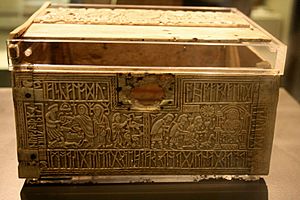
Outer Garments
Cloaks of this period included the style seen on the Franks Casket. These were made with rectangular cloth, folded to look pleated, and held together at the right shoulder with a brooch. Once in place, the brooch was left on the garment so the cloak could be slipped over the head. 800s art shows a few different cloak styles: hooded, non-hooded with a ruffled collar, and pleated cloaks arranged over the shoulders and tied at the waist with a belt. These belts were narrower than in earlier Saxon times, with fewer tools hanging from them. The wrap-over coat appeared during this era. This knee-length coat wrapped over the front of the body. Its sleeves were, as Owen-Crocker says, "deep, [with] decorated cuffs which [were] mostly straight." Common men's cloaks were simple and less decorated than those of richer men.
Main Clothes
Human figures start to appear in art during this period. Most male figures in Anglo-Saxon art wear short, above-the-knee, belted tunics. Short tunics were most common, but longer tunics are seen on Anglo-Saxon sculptures. The 700s writer Aldhelm describes a linen shirt worn under a tunic. Other writings describe the use of undergarments. It's possible that loin cloths were used as undergarments or on their own if a tunic wasn't worn.
Trousers continued to be worn by men. Traditionally worn under a short tunic or with a small cloak, they were usually ankle length. The jacket also appeared during this time. For those who could afford it, the jacket was made of fur, while less costly ones were made of linen. This jacket was waist-length and usually had a wide collar.
Leggings and Footwear
Leggings and stockings continued to be worn in the 600s to 800s. Frankish fashion for fancy gartering was very popular in the 600s.
From the early 600s, shoes became more common as burial items. A burial site at Banstead Downs found a male skeleton with soft leather ankle-boots that had eyelets for leather ties. This boot style is similar to finds from the same period in York.
Accessories and Jewelry
Archaeological finds show that the belt continued to be used in Anglo-Saxon male clothing in the 600s to 800s. Knives were often hung from belts, and in the early 600s, leather sheaths started appearing with knives. Leather and fabric pouches first appeared during this time. Many buckles were simple and small, though fancier and more expensive ones have been found. Kent burials include many large, triangular belt buckles from men's graves. The conversion of Anglo-Saxon England to Christianity is shown by buckles with cross symbols and fish emblems. As seen on the St. Mary Bishophill sculpture in York of two Anglo-Saxon men, horns could be hung from the belt.
Brooches have been rare in archaeological finds for this period. However, it's likely that disc-headed pins and other pins were worn by men, as they've been found in Anglo-Saxon settlements. The quoit brooch is a very early type. Disc brooches like the Harford Farm Brooch appear in Anglo-Saxon art in the early 600s, but haven't been found in men's graves. In the early 800s, gold was scarce and rarely found on brooches. Brooches were usually made with basic metal or silver. The Fuller Brooch and Strickland Brooch are both silver, as is the Anglo-Scandinavian Ædwen's brooch. The 800s saw the start of fancy finger-rings in Anglo-Saxon fashion.
Gloves were commonly used in Anglo-Saxon England by the early 700s. Falconers wore gloves, and pictures of gloves have been found on Anglo-Saxon sculptures. Archaeological evidence shows that fancy gloves made with fine materials have been found in Europe. This quality and style of gloves could have easily spread to England.
900s and 1000s

Writings, language, and art from the 900s and 1000s show many examples of men's fashion. There are different outfits shown: shorter clothes for average men and longer clothes for important people. Different jobs, like farming, hunting, and soldiering, needed different styles of clothing.
Outer Garments
Cloaks were worn indoors and outdoors and covered both short and long garments. Cloaks were rectangular or square, attached with a brooch, and usually not tailored. Round brooches were the most common style used by men at this time.
Main Clothes
The short tunic continued to be the standard garment for Anglo-Saxon men. They were usually knee-length, but sometimes shorter. The tunic continued to be tied at the waist by a belt or girdle. It's most likely that the tunic fabric was joined at the sides, and the neck opening was probably tied by string, ribbon, or cloth. Sleeves were thought to be either short or long, with longer sleeves more likely acting as an undergarment. Undergarments continued to be worn and were more detailed in decoration. Linen shirts or a garment similar to a nightgown could be worn under the main garment.
Leggings and Footwear
Art from this period, including the Bayeux Tapestry, shows that men continued to wear leggings and stockings. Leg coverings often covered the shoes and probably the foot. The material was likely woven cloth, as knitting wasn't introduced in England until the 1500s.
Digs in late Anglo-Saxon and Anglo-Viking London, Winchester, and York have found many shoes. These include flat-soled, leather 'turn shoes' (made inside out and then turned), and thonged shoes. The most common type of shoe is the ankle-high shoe, but lower slippers and taller boots have also been found. Flat, black shoes with a white stripe on top are the typical male footwear seen in Anglo-Saxon art during this time.
Accessories and Jewelry
Knives, hung from belts and girdles, no longer appear in Anglo-Saxon art of this period.
Brooches from the 900s and 1000s are usually round. The fanciest brooches are silver, others are made of basic metal. Small, round brooches, worn as cloak fasteners, are often shown on men in late Anglo-Saxon art. Other types of brooches found in late Anglo-Saxon graves are not seen in Anglo-Saxon art from this time.
Children's Clothing
Items found in Anglo-Saxon children's graves are rare. The little evidence we have suggests that children wore clothes similar to adults. Children's items that have been found include wrist and ankle bracelets, neck-rings, small knives, and beads. The most common accessory found in children's graves is the bead, worn alone or in small groups. Both boys and girls could be buried with a belt buckle, though buckles weren't usually worn until adulthood. Children's and adult's clothing showed differences in the type of fabric worn. A higher percentage of linen is found in children's graves compared to adult burials. Linen may have been better for children's clothes because it was much easier to wash repeatedly than wool.
Pictures and paintings from the 500s to 1000s in England always show male children. They are usually seen in short tunics with shirts. Babies are shown in long gowns, and either wear no head covering or wear one similar to women of the period.
Clothes and Social Status
An Anglo-Saxon person's wealth could be seen by how many and what kind of clothes, accessories, and jewelry they owned, and how good the quality of those items was. The importance of jewelry was shown by its size, how detailed it was, and if it used gold, silver, and garnet. Richer men and women owned footwear in the early Anglo-Saxon era, a time when many Anglo-Saxons probably went barefoot. The wealthy often had newer clothing and wore the latest fashions.
Documents show that fancy fabrics were common in Anglo-Saxon England. These included imported silks, and fabrics embroidered with gold. Most of these expensive items were mainly used as religious garments. However, it's also very likely that royals and the richest members of Anglo-Saxon society owned fancy and costly clothing.
400s to 600s
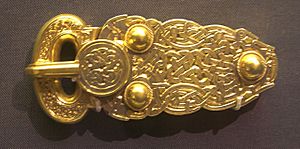
Wealth was shown by owning gold: buckles, brooches, and gold embroidery on clothes. Fancy buckles and clasps showed that the wearer was an important man in the 600s. The jacket also appeared during this time. For those who could afford it, the jacket was made of fur, while cheaper ones were made of linen. Thick, woven cloaks, which probably looked like fur, were a high-status option for men in the 600s. The extremely rich man buried around 625 AD in the Sutton Hoo Ship Burial (mound 1) had two pairs of shoes, several yellow-dyed cloaks, and possibly extra sets of jeweled belt equipment.
The Sutton Hoo Mound 1 warrior seemed dressed like a Roman general. His helmet was based on a 300s Roman cavalry parade helmet. His shield was also an oversized, decorated parade item. The gold and garnet decorated shoulder clasps probably fastened a leather tunic and looked like the shoulder armor of Roman soldiers. He also had a chain mail shirt, while a showy gold belt buckle and the garnet and gold fittings on his sword and sword belt completed the look.
700s and 800s
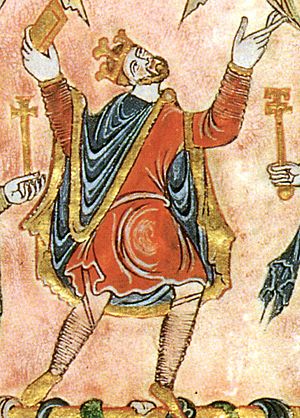
Leggings became fancier from the 600s to the 800s, with Frankish dress fashion being the inspiration. In richer graves from this period, buckles could be found under the knees and ankles of skeletons. Lace pieces found near the legs of skeletons in Kent are another sign of Frankish influence in clothing.
Art from this era showed many pictures of English kings wearing long garments. The change from shorter tunics to long clothes was likely influenced by European fashion. Gowns were often loose, with various sleeve styles.
900s and 1000s
Fur, used in earlier centuries to keep warm, became more popular outside England. In England, fur became more of a fashion choice as a luxury item during the 900s and 1000s.
Military Clothing
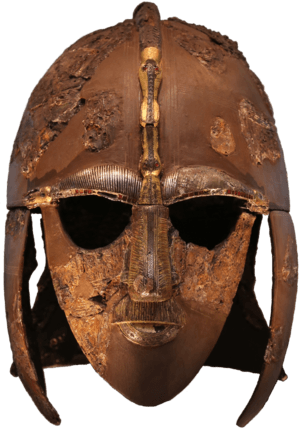
Historian Gale Owen-Crocker writes that even though heroic poems mention mailcoats (armor made of metal rings) in the Anglo-Saxon period, we don't find much proof of them in archaeological digs. Even in graves with fine weapons, they are rare. This suggests that, at least in earlier centuries, mailcoats were a rare luxury. It was not unusual to fight without protective clothing. On the Franks Casket, some spear-carriers don't have armor.
Burial finds from the 300s or early 400s in Oxfordshire (before the Anglo-Saxon migration) show that military leaders of that time wore fancy, wide belts. These belts were fastened by "a narrow strap which was riveted to the broad belt and passed through a buckle which was much narrower than the belt itself," leaving the end of the belt to hang down. Pouches were attached to the belt, allowing soldiers to carry their weapons.
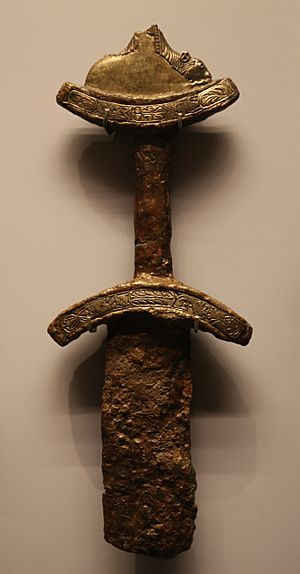
Archaeological digs in the 1990s found three 600s male graves, each with tablet-woven bands. The clothing pieces seemed to be part of a jacket. Experts studied these items and later thought they were the front borders of a wrap-over fighting jacket, like those seen on the Sutton Hoo helmet panels and other 600s art. Historians believe that Anglo-Saxon soldiers wore wrap-over, knee-length coats decorated like chain mail with sleeves that narrowed at the wrists. The jacket would be decorated with "patterned tablet woven bands stitched to the front opening and perhaps also to the hem and cuffs....Most of the comparative material suggests that the jacket was usually worn over trousers." In the 800s and 900s, military clothes weren't very different from everyday clothes. The only changes were short linen tunics with metal collars and the addition of a sword, spear, shield, and helmet. Weapons and clothing parts worn in battle were highly decorated with jewelry techniques, as seen in the discoveries at Sutton Hoo and in the Staffordshire Hoard. The idea of special parade wear didn't exist for the Anglo-Saxons.
Clothing Making
Materials Used
From the 400s to the 1000s, the materials available for making fabrics were wool from sheep, linen from flax, and imported silk. Wool came from different sheep breeds, including ancient brown sheep (like the Soay sheep today), white sheep brought by the Romans, and black-faced sheep introduced during the Viking invasions. Clothes made from sheep's wool would come in colors from white to brown and black. Silk was not grown in England but was brought in as finished clothes, lengths of cloth, or threads for sewing and embroidery.
According to Owen-Crocker, "Linen production was a longer process. It involved planting flax seeds, weeding, harvesting, removing seed pods, retting (rotting) the woody stems in water or a dewy field, drying, beating, and 'scrutching' the flax stems to break them and release the fibres inside, then repeated heckling or combing of those fibres to prepare them for spinning."
How Clothes Were Made
In the 400s and 500s, women made Anglo-Saxon clothes, weaving fabrics on looms in their homes. About 70% of a woman's year was spent making textiles. Between the 600s and 800s, Anglo-Saxon communities slowly changed from small villages to larger villages and big estates. On larger estates, special workshops would make fabrics and clothes for everyone living there. In the 900s and 1000s, as cities grew across England, the types and amounts of materials, clothing, and accessories available to people changed, as did the ways they were made.
Tests on fabric pieces from Anglo-Saxon graves show that clothes were not dyed, except for tablet-woven bands that edged women's garments. This could mean that artificial color was never used, or that the color has faded over time. It's likely that clothes were not washed often. Washing would fade any artificial dyes and would reduce wool's natural ability to keep out weather. Studies of fabric pieces from grave finds show no felting (when wool fibers lock together), which suggests clothes weren't washed frequently.
Anglo-Saxon Jewelry
Men's and women's clothes were fastened by brooches, buckles, clasps, and pins. Jewelry could be made from different metals, including iron, copper alloy (bronze), silver, or gold, or a mix of metals. Precious metals were obtained by melting down older metal objects, including Roman coins. Many brooches and buckles were decorated using techniques like casting, engraving, and inlaying.
Jewelry Styles
Women's jewelry styles changed often in the Anglo-Saxon era. In 500s Kent, for example, single jeweled disc brooches were in style until the end of the 500s. Then, more elaborate plate brooches with cloisonné garnet and glass settings became fashionable. This trend was followed by fancy composite jeweled brooches that disappeared around the mid-600s. Dress pins started to appear in the early 600s. Pendants also became popular at this time. Necklaces came into fashion, usually made with silver-wire rings and colored glass beads.
In men's graves, belt sets with triangular plates, inspired by Frankish fashion, appeared in the late 500s and lasted through the first half of the 600s. Later in the 600s, small buckles with rectangular plates became common.
Finger rings were worn in the early Anglo-Saxon era, but became less popular in the 600s and 700s. They became fashionable again in the 800s. At the end of the 600s, round brooches became more popular than long brooches, and ring-shaped and disc brooches started appearing in graves. 700s round brooches are rarely found, but many examples have been found from the 800s to 1000s.
Brooches that look like modern safety pins appeared in the 600s. Straight pins continued to be popular in the 600s, and were sometimes made of gold and silver. Strings of beads, which decorated women's clothes in the 400s and 500s, faded from view in the 600s. The most noticeable jewelry fashion change in the 600s and 700s was the use of necklace pendants. These pendants were inspired by a mix of Frankish, Byzantine, and Roman art. Straight pins continued to be popular in the 900s and 1000s. They were seen as useful items during this time and were made in large quantities. Finger rings continued to be popular.
Making Jewelry
Men and women continued to wear noticeable jewelry, much of which was practical, like clasps to fasten clothes (buttons were not used). Precious metals were used by those who could afford them. In the early Anglo-Saxon era, most jewelry was perhaps made by traveling craftsmen who moved from village to village. Some jewelry was made by monks, who also made religious metalwork. From the 600s to the 800s, Anglo-Saxon communities slowly changed from small villages to larger villages and big estates. On larger estates, special workshops would make jewelry and metalwork for the people living there. In the 900s and 1000s, as cities grew across England, the types and amounts of jewelry available to Anglo-Saxons changed, as did the ways jewelry was made.
See Also




